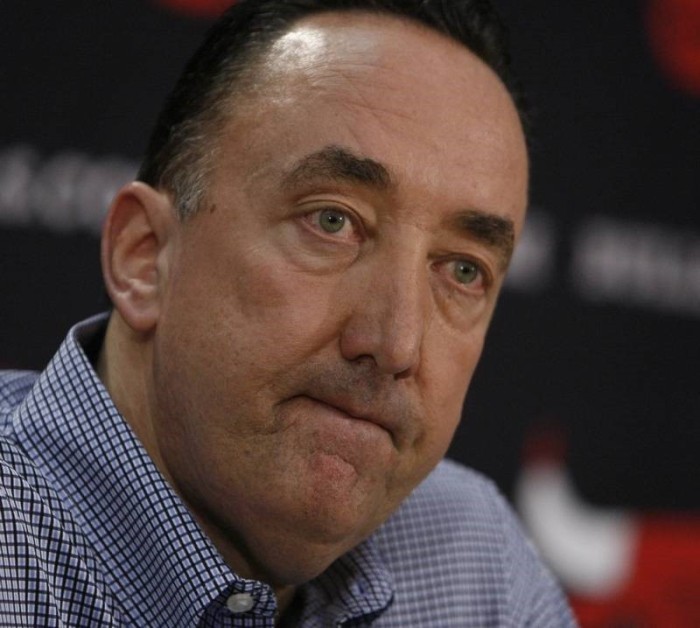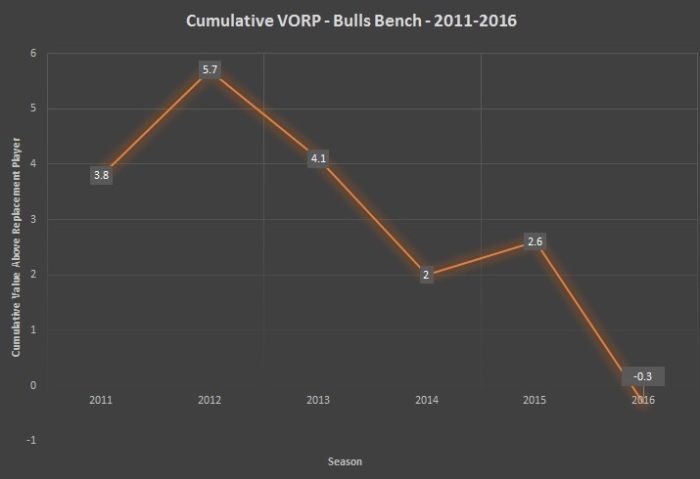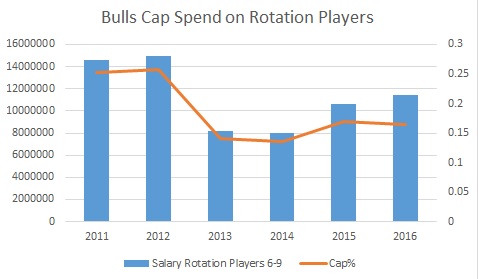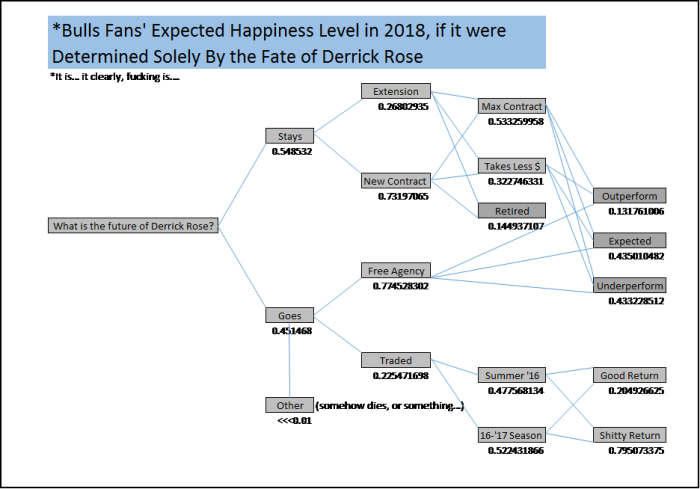
In the wake of the Bulls acquiring Dwyane Wade and Rajon Rondo, I wanted to write about how GarPax had once again crapped the bed, and to describe how they’ve set the team up for failure while once again dealing Fred Hoiberg an unsolvable personnel puzzle incapable of being fit to run the offense he envisions. While they certainly have put Hoiberg behind the 8-ball in this way, the more I analyzed and wrote, I could not escape the conclusion that this is the best course of action for the time being.
The alternative to the summer-of-’16 re-tooling would have had the Bulls opting to deal Jimmy Butler, and signaled the wholesale destruction of the roster and a rebuilding period to come. While I accept that the Bulls definitely listened to offers for him as reported, it would have only made sense to pull the trigger if they were getting a massive haul of lottery level picks and/or young NBA talent in return – In short, an offer they couldn’t refuse. The value the Bulls now have in Butler on his 5-year, $95 million contract which he signed just 1 year ago is looking like a bargain, particularly for a player of his caliber. Jimmy has established himself as an elite defensive player having been named 2nd team all-defense by the NBA the last three years running. He’s a top 3 defender in the league at either shooting guard or small forward and is as astute a team defender as he is locking guys down while on the ball. Further, he has the quickness, size and strength to ably switch off onto point guards or power forwards as matchups dictate. He’s also proven to be a passable first option on offense, improving year over year in leaps and bounds since he entered the league in 2011 (see career stats below). He has exceeded draft-day expectations with a work ethic that is seldom matched, much less exceeded.
| Jimmy Butler – Career Stats | |||
| Year | PPG | APG | MPG |
| 2011-2012 | 2.6 | 0.3 | 8.5 |
| 2012-2013 | 8.6 | 1.4 | 26.0 |
| 2013-2014 | 13.1 | 2.6 | 38.7 |
| 2014-2015 | 20 | 3.3 | 38.7 |
| 2015-2016 | 20.9 | 4.8 | 36.9 |
| 2016-2017 | 25.1 | 4.1 | 35.2 |
Contrast his $95 million salary with the numbers that were dropped on far lesser (not to mention injury prone) talents over the summer:
- Mike Conley Jr. – 5yr/$150mil
- Bradley Beal – 5yr/$128mil
- Nicolas Batum – 5yr / $120mil
By comparison, Butler is a steal at his price, and the average salary over the full term of the contract is really even lower since the $19M+ for which he’s penciled in for the 5th year is on a player option he would most definitely exercise barring some miracle concocted by the Bulls front office to re-build the team to contender status by then. For the time being, building something around Butler, even if it can’t yield a championship caliber roster makes logical sense in the following ways:
- It’s likely to placate season ticket holders and die-hard fans who must be somewhere on a continuum of anger to sadness over the departure of Derrick Rose and Joakim Noah. Of perhaps even greater importance here is that signing Wade preserves some ticket value on the secondary market, as well as making the team more interesting to watch over the course of an 82-game regular season. In the short-run, at least, it’s a win for the fans.
- Assuming management couldn’t get a good return for Butler, they are basically obligated to build around him. The alternative is to let him languish on an otherwise weak roster. That tack is problematic since it would only serve to devalue Butler on the trade market as the team struggles, and may even alienate him to the point he then demands a trade and further weakens any leverage the Bulls might have in dealing him.
- The Bulls did NOT over-spend as other franchises ‘made it rain’ this summer, and will have room for a max free agent going into 2017-2018 even if Wade opts in for year two of his contract. Taj Gibson and Niko Mirotic are off the books after this year and the Bulls also have the option of dumping Rondo. This leaves them around $62 million committed to Butler, Lopez, Wade, McDermott, Grant, and Portis.
I had taken an extremely pessimistic view on Rondo because he’s got an overwhelmingly bad track record as a cancerous, uncoachable stain on any team he’s played for the last half decade. This is perhaps best symbolized by the Mavs leaving Rondo out in the cold when doling out playoff compensation in 2015. However, since he’s been in Chicago, he’s shown up to work with the younger players at the Las Vegas summer league, and made news for building a relationship with a group of at-risk kids on Chicago’s west side with whom he’s been working since before he even joined the Bulls. While he’s doing and saying the right things, the real motivator for him to change his behavior will of course be money. He was quoted by the New York Post after the end of last season saying “I want to make this – whatever I do – my last stop”. Unfortunately for him, there was basically no market for his services. The Bulls desperately needed a starting point guard given the departure of Rose and took what amounted to a very low-risk flyer on him. His deal nets him around $14 million for each of the next two seasons at which point he’ll hit the market again as a 32 year old unrestricted free-agent in what will likely be his last shot at real money. The Bulls have to hope he’s motivated to prove all his detractors (pretty much everybody) wrong. The bottom line is that the Bulls are buying low here, and gave themselves a team option to bail on Rondo after this coming season.
Regardless of the future success or lack thereof with this group, questions will abound over whether fielding a middling team good enough to make the playoffs but not truly contend is worth it in the long run. The Bulls’ approach to free agency is beginning to mimic that of the other Reinsdorf-owned Chicago sports franchise: The White Sox. The Sox have a track record of cyclically signing “risky”, (read: older) second-tier players in free-agency hoping they can catch lightning in a bottle and make a playoff run. They clearly favor this approach over bottoming out in the hope of landing high draft picks with which to rebuild. However, this method is problematic in the NBA where the bar is significantly higher to attain the status of a contender.
The dynamic of the NBA playoffs is unlike that of baseball. It has been proven with statistical rigor that simply making the MLB playoffs is the entire goal of the regular season and that, ex post facto narratives aside, the eventual champion is crowned more as the result of a random set of outcomes in the post-season than it is an actual whittling down of that elite group to the one best team. The opposite is true in basketball, where the cream always rises, and playoff success correlates well with regular season success. To win a championship in the NBA requires a bonafide superstar: One of the top few players in the league who then leads a roster constructed specifically to complement their superior talents. Obviously, there are two ways to acquire such a player… either through the draft, which nearly always requires one of the top 3 picks, or via trade/free agency. Given the inability of the Bulls to attract a big-ticket free agent in his prime (Note: It’s NEVER happened in the history of the franchise) One might argue that the only way for them to ever get back to contender status is to bottom out and take their swings in the draft.
A quick aside… If you’re thinking that the 2004 Pistons proved that there is indeed a 3rd path to a title, I’d argue that this would be nearly impossible to replicate today. The current free agency climate can best be described as a once-in-a-lifetime bonanza for those mediocre players fortunate enough to hit free agency in 2016 or 2017. Players that would rate not far above league average at their position are signing maximum salary contracts as the salary cap explodes. The notion of putting 5 players who are all well above average at their position on the court at the same time would not be possible with the primary means of acquisition being free agency. At least a couple of them would have to be on rookie-scale contracts (i.e. draft acquisitions), which in the current CBA / salary cap set-up are of even more value than usual.
Beyond the difficulties in deciding on a long term approach to building their roster, the Bulls do not suffer as do the Sox (even when they’re playing well) to attract fans. In short, they don’t have the same revenue concerns. This is evidenced by the Sox bottom-5 attendance figure the first half of 2016 despite a promising start. On the other hand, the Bulls draw consistently no matter the quality of the roster. Still coasting on the Jordan-era dynasty, the Bulls are as close to ‘recession-proof’ as you can get in the NBA. During their worst stretch of the last 3 decades, between ’99-’00 and ’08-’09, roughly the gap between the Jordan-era and the D.Rose-era, the Bulls still ranked first in the NBA in attendance by a sizable margin pulling more than 20% higher than the league average for that period:
| Team | Attendance | Rank |
| Bulls | 20,891 | 1 |
| Pistons | 20,186 | 2 |
| Spurs | 19,467 | 3 |
| Knicks | 19,311 | 4 |
| Jazz | 19,234 | 5 |
| Mavericks | 19,186 | 6 |
| Lakers | 18,934 | 7 |
| Raptors | 18,553 | 8 |
| Trail Blazers | 18,422 | 9 |
| Heat | 17,763 | 10 |
| League Average | 17189 | |
Only time will tell the intentions of the Bulls front office. They could very well trade one or more of their poor man’s ‘big 3’ to get younger or obtain picks should injuries, chemistry issues, or other failings arise this season but early returns are positive and it appears they intend on making a run with this group. While the media skewered Gar last summer for the mismatching of his actions in signing re-treads like Rondo and Wade with his words which were “younger and more athletic”, the reality is that these signings were individual decisions which he likely felt he had to make. In the case of Rondo, the Bulls desperately needed a serviceable point guard given the departure of Rose. With Wade, it was more ‘asses-in-seats’, national TV appearances, jersey sales, keeping the team interesting enough to be in the national conversation, and all the other trappings of signing a guy with a marquee name. Three months ago, I’d have argued it’s just a Pau Gasol redux: Bringing in the big name that resonates with fans and over-paying for unrepeatable past successes. Fortunately for the Bulls, I was wrong in my estimation of Wade’s impact on this team. He’s been a true leader, commanding a respect reserved only for those who have won championships. Wade has also worked with Hoiberg on his Achilles’ heel: 3-point shooting and has managed to improve to the point he’s now an outside threat. Provided they can stick to a plan of giving him games off to rest, he’s clearly got plenty left in the tank to be an effective scorer and playmaker. While a lot of the short-term questions have been answered by a solid start to the season, we’re still left with the conundrum of how the franchise should plan to return to contender status. Can we take a historical look at the approaches of rebuilding teams to see if there is a statistically ‘right’ answer for how to go about that process?
To begin, the Bulls recent history over the course of the last nine seasons actually reflects a somewhat typical evolution viewed from 30,000 feet despite all the agonizing twists and turns comprising that path. They went from a young and bad team, to a young and competitive team to an older but competitive team before rapidly devolving to ‘old and bad’ status. My goal was to examine NBA teams in rebuilding-mode, looking only at franchise states of ‘bad’ (i.e. – missed the playoffs and entered the draft lottery) to see how the future paths unfolded going forward. Specifically, over what timeframe does a team get back to the status of an elite contender? For the study, I considered only the period of 1985-2016. 1985 was my chosen starting point because it was the first year of the draft ‘lottery’ in the NBA. My definition of ‘elite contender’ is somewhat nebulous, but includes any team that either made the finals, or otherwise had a legitimate shot at a title that season. For the latter group, think 2002 Kings or 2000 Trailblazers.
Not surprisingly, the number of lottery appearances by franchise is normally distributed, implying that luck does indeed play a significant role in this cyclic process of teams phasing in and out of contention:

It’s worth noting the one team represented on the far left end (least lottery appearances) of this graph is the San Antonio Spurs, who have appeared in the lottery only 3 times, selecting David Robinson 1st overall in 1987, Sean Elliott 3rd in 1989, and Tim Duncan 1st in 1997. Think about that… They were lucky enough to draw the #1 pick twice, and both times it was in a year where they were able to draft a franchise center. Give them credit for pulling another contributing piece to that first championship group with Elliott, and for surrounding them with complementary talent and a hall-of-fame coach, but the success of their franchise is certainly as much luck as it is skill.
There’s no doubting Gar Forman was telling it like it is, stating last summer: “When you’re deep in the lottery, it takes years and years to get back.” The truth is it will generally take years to get back even if you’re at the top of the lottery, unless your year happens to coincide with the opportunity to obtain an elite talent, which only occurs in about 50% of drafts even if you include guys whose careers were derailed due to injury (Rose, Oden, Jay Williams, etc.) Here’s a list of ‘franchise’ players drafted in the lottery-era who did not ‘flame out’. For these purposes, ‘Franchise player’ includes any guy who was the best player or in a 1/1a tandem which led a team to the finals… plus I added Scottie Pippen since I love Scottie Pippen (Note: I really do believe he achieved ‘1a’ status w/M.J. during the second three-peat):
| Franchise Players – Lottery Era | ||||
| Player | Pick | Year | Finals | w/orig. tm |
| Steph Curry | 7th | 2009 | 2 | 2 |
| Kevin Durant | 2nd | 2007 | 1 | 1 |
| Dwight Howard | 1st | 2004 | 1 | 1 |
| LeBron James | 1st | 2003 | 7 | 3 |
| Paul Pierce | 10th | 1998 | 2 | 2 |
| Dirk Nowitzki | 9th | 1998 | 1 | 1 |
| Tim Duncan | 1st | 1997 | 6 | 6 |
| Allen Iverson | 1st | 1996 | 1 | 1 |
| Kobe Bryant | 13th | 1996 | 6 | 6 |
| Kevin Garnett | 5th | 1995 | 2 | 0 |
| Shaquille O’neal | 1st | 1992 | 5 | 1 |
| Gary Payton | 2nd | 1990 | 1 | 1 |
| David Robinson | 1st | 1987 | 1 | 1 |
| Scottie Pippen | 5th | 1987 | 6 | 6 |
These 14 guys drafted over the last 30 years accounted for 42 finals appearances, with a few overlaps among them. 32 of those 42 involved that player and the team that drafted them (or in the case of Kobe and Scottie – that acquired them on draft day). This would seem to argue for building through the draft, but the current climate of NBA free agency and the super-team-era kicked off by the 2008 Celtics and cemented with LeBron James and his infamous ‘Decision’ in the summer of 2010, may have shifted this calculus a bit.
Circling back to the evolution of a contender… Following the abrupt end to the Jordan era in 1998, the Bulls have been through 3 separate rebuilds: The Curry/Chandler/Jay Williams era of the early 2000’s which failed to launch due largely to Williams’ career ending motorcycle injury. Then there was the Ben Gordon/Kirk Hinrich/Luol Deng era of the mid-2000’s which jumped directly to the 2010’s Derrick Rose/Joakim Noah era thanks to that 1.7% lottery miracle in 2008.
In the history of the league, there have been many contenders built by cobbling together a strong roster via trade and free agency (the aforementioned 2000 Trailblazers and 2002 Kings to name two), but only 3 situations where that contender reached the ultimate goal. These were the Lakers 3-peat team of 2000-2002, the 2008 Celtics, and the back-to-back champion Heat of 2012-2013. All three of these relied on the same formula:
- Destination team already possesses an elite star (Kobe / Pierce / Wade)
- An additional elite star(s) hit free agency in his prime and chose to leave an organization for what they perceived to be greener pastures.
While this formula seems simple, maybe one fifth of all NBA teams possess such an elite talent. Roughly, that list looks like this:
- Cavs – LeBron, Kyrie
- Warriors – Durant, Curry
- Thunder – Westbrook
- Pelicans – Anthony Davis
- Clippers – Chris Paul
- Rockets – James Harden
At this point, age/retirement/injury have pushed several guys that were in this group as recently as 5 years ago to the side. (Kobe, Duncan, Dirk, Dwight Howard, Nash, D.Rose, Pierce) A relevant question then is what young players might have the ability to join this group? Kawhi Leonard? Damian Lillard?? Andrew Wiggins??? That list might prove to be even shorter than that of the current top-tier stars. For the Bulls the only thing that matters is whether they believe Jimmy Butler can be one of those guys. For the moment though, let’s assume he can’t…
Considering that the contender-via-free-agency model has the built-in prerequisite of acquiring a franchise cornerstone through the draft, why would the Bulls not bottom out as rapidly as possible and take their chances in the lottery? The answer is simple: Due to all the luck required to hit big in the draft, the timeline to rebuild a franchise to contender status is historically well north of a full decade. I had a very difficult time even attempting to quantify this….but here’s how I did it:
First – I looked at spans of time between fading and reemerging from contender status where at least part of said span occurred in the lottery era. (1985 or later)
Second – Only spans where a franchise eventually did return to contender status were considered. It’s worth noting that by the definition of ‘elite contender’ I outlined earlier, 8 of the NBA’s 30 franchises have NEVER contended during the lottery era. (Bobcats/Hornets, Nuggets, Clippers, Grizzlies, Bucks, Hornets/Pelicans, Raptors, Bullets/Wizards) Here’s an example where a franchise faded and eventually returned: The Lakers faded from contention in 1992 (Magic’s HIV retirement) and returned in 2000 (Rise of Shaq/Kobe 3-peat). This is considered to be an 8 year ‘rebuild’. Here are the statistics for all NBA franchises:
- Average time to rebuild = 14.16 years.
- Longest rebuilding period = 40 years (Warriors: 1975 – 2015)
- Shortest rebuilding period = 4 years (Heat: 2006 – 2010)
This 14.16 year average is a bit misleading as it only considers ‘closed’ loops where a franchise did eventually work their way back to contention. If you consider ongoing stretches of non-contention (and the ‘never contenders’ each factored in at the 31 year span of the lottery era) the average climbs even higher to 15.64 years. While these numbers may skew high due to an unlevel playing field given relative market sizes, one can see why the Bulls would be hesitant to throw in the towel knowing the route back to prominence may take 15 years if the balls don’t (literally) bounce their way.
A cynic would dismiss the Bulls’ current rebuild-on-the-fly attempt as the desperation of an 80-year old owner in Jerry Reinsdorf who wants one more shot at a title before he kicks the can. But, given the likely timeframe of a full rebuild and the relatively new dynamic of star players shuffling about the league in the current-day NBA, I believe it’s easier to make a reasoned case for the Bulls’ approach… Even if it doesn’t carry a very high probability of that ultimate ‘success’.
Can Jimmy Butler make the leap from ‘all-star’ to being an elite player capable of carrying a franchise? Only time will tell. For now, we can enjoy Wade’s twilight years and have hope the franchise can once again turn the corner. If they can’t…. Oh well… See you in 2032!






You must be logged in to post a comment.